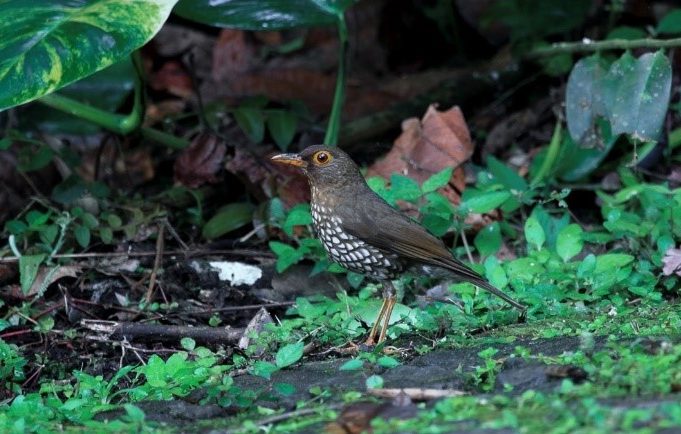Birdfinding.info ⇒ Locally common but declining, shy, and much more easily heard than seen. On Montserrat, it can be found throughout the Centre Hills. On Guadeloupe, it is common in the forests of Basse-Terre. It typically feeds in the open in the early morning and late afternoon in places at forest openings—sites where it is often seen in these situations include Cascade aux Ecrevisses and Corossol.
Forest Thrush
Turdus lherminieri
Endemic to the Lesser Antilles: Montserrat, Guadeloupe, Dominica, and formerly St. Lucia. In most of its range, it inhabits primary humid forest, but on the eastern side of Guadeloupe (Grande-Terre) it occurs in second growth and forest patches.
Consists of three distinct forms:
“Northern Forest Thrush” (lherminieri and dorotheae): Montserrat and Guadeloupe.
“Dominica Forest Thrush” (dominicensis): Dominica.
“St. Lucia Forest Thrush” (sanctaeluciae): St. Lucia, but now apparently extinct.
(Reasons for this subdivision of forms are explained in the Notes below: Frontiers of Taxonomy: the Forest Thrush Complex. The remainder of this page primarily describes the “Northern Forest Thrush”. For more detailed information on the “Dominica Forest Thrush”, follow the link.)
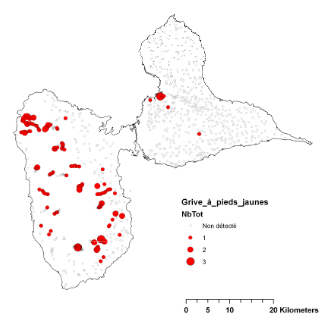
Forest Thrush survey results on Guadeoupe. © Eraud et al. 2013
On Guadeloupe, it is far more numerous and widely distributed on the western side of the island (Basse-Terre).
Identification
Warm brown upperparts with a brown-and-white scaly pattern over most of the underparts. The white scales are small on the throat and chest, and become progressively larger toward the belly. The lower belly and vent are white. It has a pronounced yellow eyering and bill, and very long yellow legs.

Forest Thrush. (Centre Hills, Montserrat.) © Dr. Mike Pienkowski
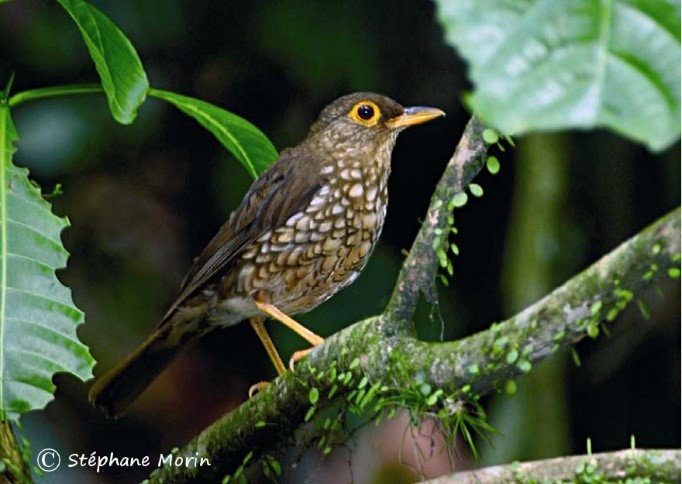
Forest Thrush, showing its broad, bare, bright yellow eyering. (Guadeloupe.) © Stéphane Morin
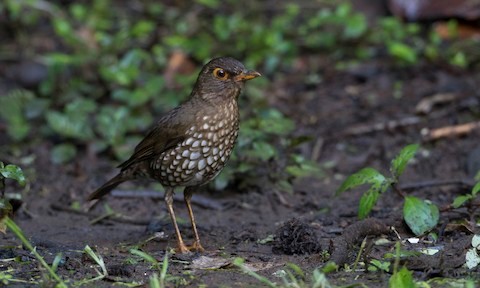
Forest Thrush. (Cascade aux Ecrevisses, Guadeloupe; March 4, 2018.) © Brian Sullivan
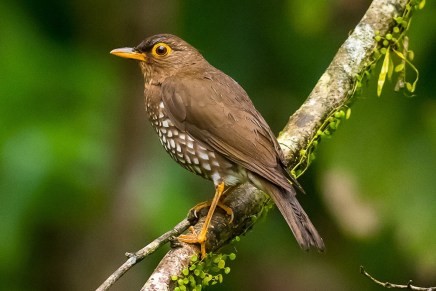
Forest Thrush. (Guadeloupe.) © Frantz Delcroix
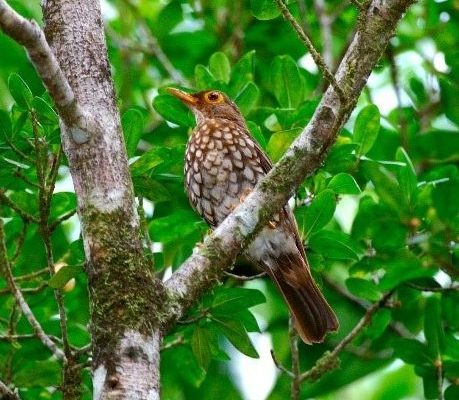
Forest Thrush. (Guadeloupe.) © Stéphane Morin
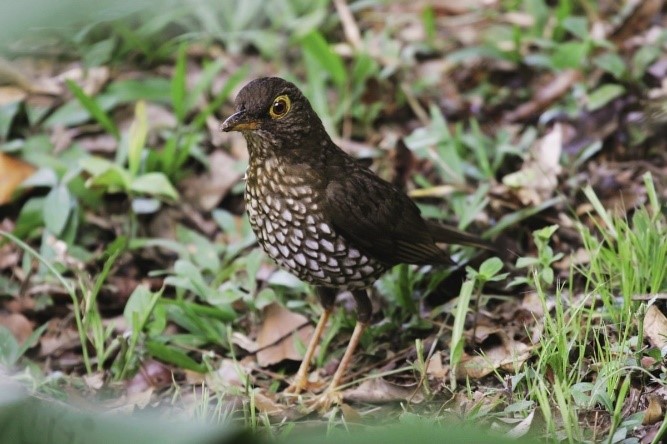
Forest Thrush, in a typical posture that resembles an antpitta. (Guadeloupe.) © Anthony Levesque

Forest Thrush. (Corossol, Guadeloupe; October 17, 2018.) © Peter Kaestner
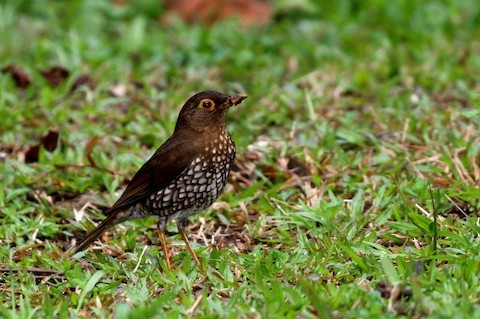
Forest Thrush. (Corossol, Guadeloupe; March 17, 2017.) © Anthony Levesque
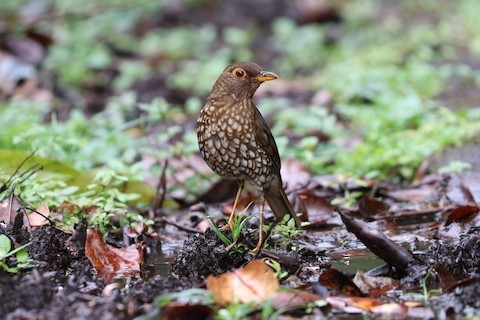
Forest Thrush. (Grand Etang, Guadeloupe; January 30, 2018.) © Anthony Levesque

Forest Thrush, close-up. (Centre Hills, Montserrat.) © The Montserrat Reporter
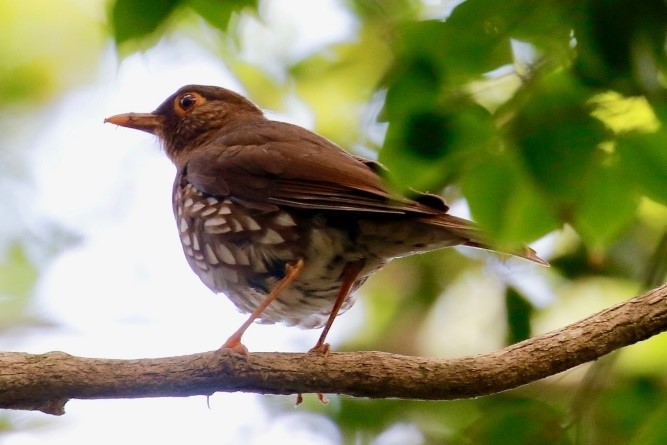
Forest Thrush. (Centre Hills, Montserrat; April 19, 2018.) © Bird Explorers

Forest Thrush. (Cascade aux Ecrevisses, Guadeloupe; March 4, 2018.) © Brian Sullivan
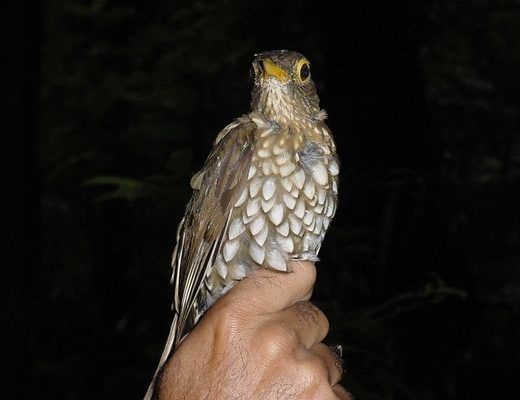
Forest Thrush, showing the large scale-patterned feathers on its underparts. (Guadeloupe.) © Guadeloupe National Park
Notes
Polytypic species consisting of four recognized subspecies, separable into three distinct forms, the “Northern Forest Thrush” (lherminieri and dorotheae) “Dominica Forest Thrush” (dominicensis) and “St. Lucia Forest Thrush” (sanctaeluciae, probably extinct). The current subspecies lherminieri includes two genetically divergent populations that almost certainly merit recognition as separate subspecies.
Formerly placed in the monotypic genus Cichlherminia.
IUCN Red List Status: Vulnerable.
Frontiers of Taxonomy: The Forest Thrush Complex.
The internal taxonomy of the Forest Thrush complex is unresolved and in need of revision. Recent research suggests that it may consist of multiple species, with the populations on Montserrat and Guadeloupe comprising one species with three subspecies, and the populations on Dominican and St. Lucia both likely recognizable as separate species—although the St. Lucia form evidently died out in the late 1900s.
The “Dominica Forest Thrush”, T. l. dominicensis, differs visibly and vocally from those of Montserrat and Guadeloupe. Visibly, the Dominica form is darker brown overall and has a white belly, and a finer scaling pattern on the breast and flanks. Vocally, its song is simpler, choppier, and less musical than “Northern’s”, and includes a sharp upslurred note frequently interspersed (and likely differs in other ways, but few recordings of Forest Thrush songs are available for a more thorough review).
The “St. Lucia Forest Thrush”, T. l. sanctaeluciae, has not been reliably reported in recent decades and is likely extinct. Although Forest Thrushes are secretive and difficult to see, they are not difficult to hear, so the failure of intensive searches to locate any singing individuals strongly suggests that sanctaeluciae no longer exists. Documentation of its appearance and song is not readily available, so its distinctness is difficult to evaluate, but geography and the isolation of dominicensis suggest that sanctaeluciae must have been at least as divergent genetically as dominicensis—probably more so given that it was separated by a much greater distance, including the island Martinique, where no subspecies of Forest Thrush has been recorded.
The populations of Montserrat and Guadeloupe—currently designated as T. l. dorotheae and lherminieri—generally resemble one another, but show significant divergence in measurements and genetic markers. However, the research of Arnoux et al. (2014) indicates that the populations of eastern and western Guadeloupe are more divergent from one another than from the Monstserrat population, which indicates that there should be two subspecies recognized on Guadeloupe. With recognition of the Dominica and St. Lucia forms as distinct, and named accordingly, the natural designation for the remaining group would be “Northern Forest Thrush,” T. l. lherminieri.
References
Arnoux, E., C. Eraud, N. Navarro, C. Tougard, A. Thomas, F. Cavallo, N. Vetter, B. Faivre, and S. Garnier. 2014. Morphology and genetics reveal an intriguing pattern of differentiation at a very small geographic scale in a bird species, the forest thrush Turdus lherminieri. Heredity 113:514-525.
BirdLife International 2018. Turdus lherminieri. The IUCN Red List of Threatened Species 2018: e.T22708544A132073400. http://dx.doi.org/10.2305/IUCN.UK.2018-2.RLTS.T22708544A132073400.en. (Accessed August 31, 2019.)
Collar, N. 2019. Forest Thrush (Turdus lherminieri). In Handbook of the Birds of the World Alive (J. del Hoyo, A. Elliott, J. Sargatal, D.A. Christie, and E. de Juana, eds.). Lynx Edicions, Barcelona. https://www.hbw.com/node/58323. (Accessed August 31, 2019.)
eBird. 2019. eBird: An online database of bird distribution and abundance. Cornell Lab of Ornithology, Ithaca, N.Y. http://www.ebird.org. (Accessed August 31, 2019.)
Eraud C., A. Levesque, G. Van Laere, and H. Magnin. 2013. La Grive à pieds jaunes (Turdus lherminieri) en Guadeloupe : État des connaissances sur l’importance et la répartition des effectifs. Rapport d’étude ONCFS-Parc National Guadeloupe. http://www.guadeloupe.developpement-durable.gouv.fr/IMG/pdf/eraud-levesque-van_laere-magnin_2013-png_oncfs.pdf.
Raffaele, H., J. Wiley, O. Garrido, A. Keith, and J. Raffaele. 1998. A Guide to the Birds of the West Indies. Princeton University Press, Princeton, N.J.
